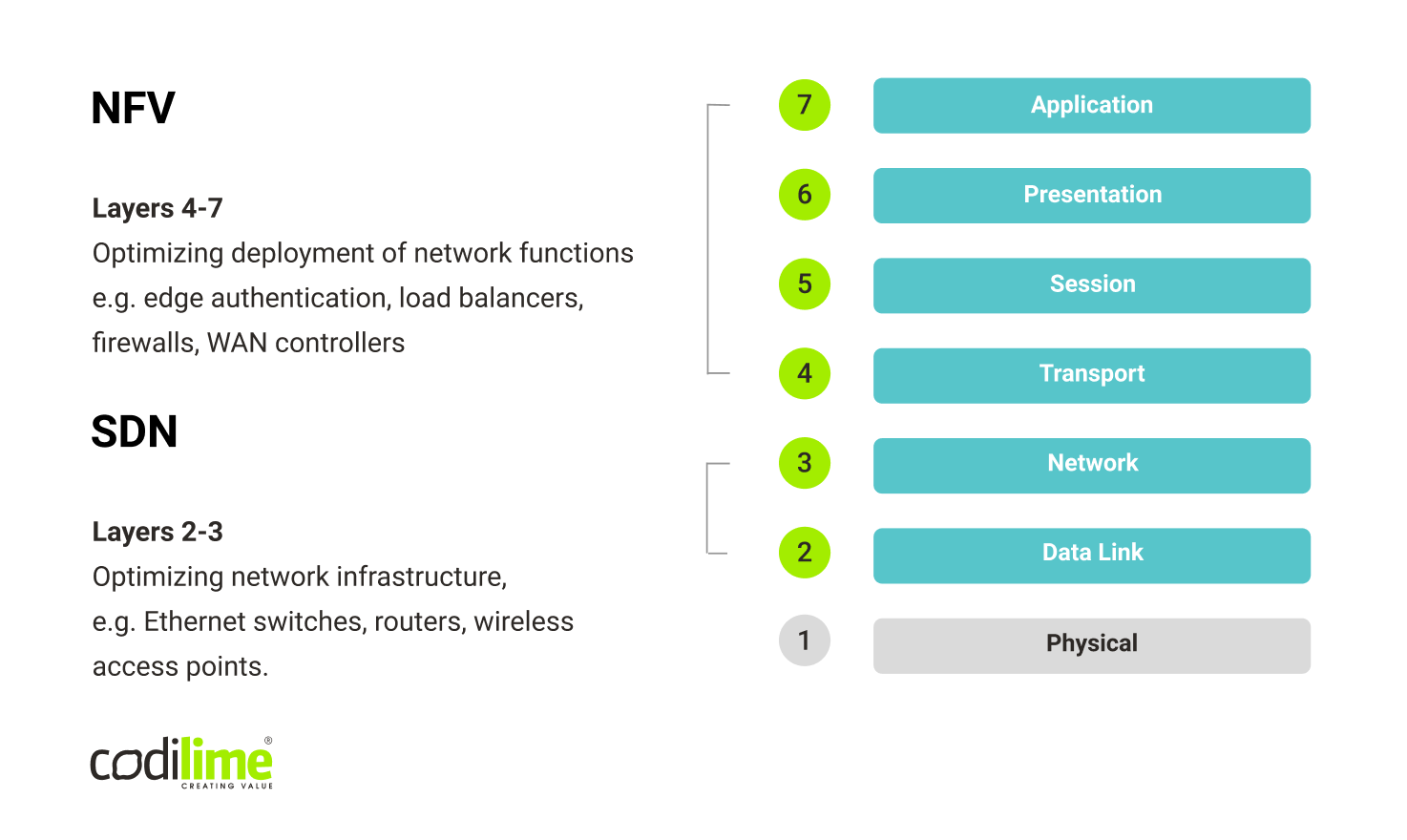Network Function Virtualization (NFV) and Software Defined Networking (SDN) technologies are similar and can easily be mistaken for one another. Given their growing popularity of late, it is good to know what SDN and NFV stand for, why they are so popular and what business benefits you can expect from them.
Living in the Zettabyte Era
In 2016, Cisco published the report “The Zettabyte Era: Trends and Analysis” announcing that by the end of 2016 annual global IP traffic would pass a zettabyte. To be mathematically precise, a zettabyte
is a measure of storage capacity equal to 1021 (1,000,000,000,000,000,000,000) bytes. That’s approximately equal to a billion standard laptop hard drives with a capacity of 1 terabyte (i.e 1024GB).
So in 2020, we are undoubtedly living in the Zettabyte Era. As of June 30, 2020, 62% of the world population are active Internet users. It is almost 5 billion people or 3.5 times more than the current population of China, the most populous country in the world. These numbers are bound to grow. It is predicted
that by 2023 66% of the global population will have Internet access. This means 5.3 billion Internet users streaming videos, posting photos, sending emails, using social media, etc. In fact in 2019, every minute of the day
, 4,500,000 videos were watched on YouTube, 511,200 tweets were sent on Twitter and 4,497,420 searches were conducted on Google.
This massive growth has two sources: the growing M2M connections (machine-to-machine or more commonly referred to as Internet of Things—IoT) that are predicted to reach half of the global connected devices by 2023, and mobile devices. It is estimated that over 70 percent of the world population will have mobile connectivity by 2023. The 5G roll-out currently underway will foster this growth by offering higher bandwidth.
The explosion of transfer usage and the devices connected with the global network will increase the need for technology to support it. Enabling a growing number of devices to effectively connect with the Internet means more sophisticated networks will have to be built out. On top of all that, the popularity of cloud computing is growing, making global companies more dependent on reliable and fast internet traffic, compelling them to use NFV and SDN. But what are the benefits and the difference between these technologies?
Here, you can check out our network services.
SDN—a novel approach to networking
From our introduction to SDN, it is a novel approach to building networks, allowing them to be programmatically and dynamically controlled. SDN means the separation of the control plane and the data plane. The control plane is the layer where the network behavior is defined and managed while the data plane is the layer where the packets are processed. Such an approach offers considerable business benefits:
- The administrator gains control over the whole architecture of the network with a single control panel.
- A clear view on the network topology allows for better decision-making, e.g. more efficient load balancing and better traffic distribution.
- It’s easy to add new components to the network.
- You don’t have to configure hundreds of devices, as everything can be done from a single control panel.
- It is much easier to redesign network architecture without the need to rewire anything.
- SDN technology provides redundancy and scalability at almost no additional cost.
- Network configuration is compiled automatically thus minimizing the risk of human error.
- SDN provides automation for networking technology, making the administrator’s work easier and faster.
- The administrator can control the system’s security more easily than in traditional networks.
See the differences between SDN vs traditional network
NFV—cutting costs intelligently
One brick in the foundation of Network Function Virtualization (NFV) is network services providers’ need to optimize the cost of the machines they use to build networking solutions. By using virtual network functions (VNFs) to emulate networking equipment, they have gained the ability to use cheaper commodity hardware instead of costly specialized solutions. Instead of buying a specialized edge router, firewall and WAN Accelerator, the company could run all the functions within a computing cloud, as virtual machines emulating the functions of the hardware. Furthermore, an increasingly popular trend of developing containerized applications has also entered into the networking world allowing companies to use containers to create network functions. These are Cloud-native network functions (CNFs).
NFV architecture has the following components:
- Virtualized network functions (VNFs)—software network elements (or groups of connected network elements) that emulate networking hardware and perform network services. They run on Virtual Machines (VM) and can be managed by Virtual Infrastructure Managers (VIMs) like OpenStack.
- Network function virtualization infrastructure (NFVi)—a virtualization layer that provides hardware resources (compute, storage and network resources) and supports software (Virtual Infrastructure Manager—VIM, hypervisor for VNF management and NFV Orchestrator) to allow VNFs to perform their network functions.
- Management, automation and network orchestration (MANO)—a framework for NFV infrastructure management that also allows you to create new VNFs.
The European Telecommunications Standards Institute (ETSI) helps define standards for each component of the NFV infrastructure.

What is the difference between SDN and NFV?
SDN and NFV technologies are complementary yet independent.
- SDN manages the whole network with a single centralized controller. It is recommended to build an SDN solution with NFV controllers, but it is not necessary. Sometimes the functionality desired comes from the software itself—a separate firewall may be redundant when the security rules are managed by the controller.
- NFV is all about emulating hardware. It is possible to build a physical network with commodity software and wires, without building an actual SDN. Such a network is cheaper, but requires the same amount of work to manage and maintain.

NFV includes Layers 4-7 and allows you to optimize deployment of network functions such as edge authentication, load balancers, firewalls or WAN controllers. SDN is responsible for Layers 2-3 and optimizes network infrastructure, e.g. Ethernet switches, routers, wireless access points.
>> See also: What are the benefits of SD-WAN.
The business benefits of combing SDN and NFV
Combining SDN and NFV technologies allows companies to maximize the benefits of virtualizing their network environment with virtual machines and by building even the most sophisticated networks within data centers.
- It’s cheaper—there is no need to buy specialized hardware.
- Vendor lock-in is avoided—there is no need to buy dedicated hardware, as virtualized network functions can be run on standard commodity hardware.
- It’s more secure—the administrator is able to establish the security rules for all components from a single control panel
- It can be automated—there is no need to send a maintenance specialist to the physical location of a router or any other network component. Everything is done from one control panel. Specialists are sent only to attend to the most offline activities, such as repairing a damaged physical network.
- It’s easily scalable—when network traffic grows, you can create more VNFs to handle it.
- The environment is flexible—adding or removing a component takes mere seconds. There is no need to buy a physical machine and have it delivered and wired into the network, nor later to have it removed. With less cash tied up in unused hardware, costs are ultimately reduced.
- It is easy to monitor—the administrator has a clear overview of the entire network topology from a single control panel and can manage it more efficiently.
Summary
It is possible to use SDN technology without using NFV and the other way round: use NFV alone without SDN. But the technologies are complementary and using them separately limits the benefits a business will gain. Ultimately, to gain competitive advantage and streamline operating costs, embracing SDN and NFV technologies will become necessary.







